Samsung Galaxy Tab Pro 8.4 and 10.1 Review
by Jarred Walton on March 22, 2014 9:30 PM ESTPerformance Benchmarks
In the world of laptops where I come from, we’re fast reaching the point – if not well beyond it – where talking about raw performance only matters to a small subset of users. Everything with Core i3 and above is generally “fast enough” that users don’t really notice or care. For tablets, the difference in speed between a budget and a premium device is far more dramatic. I’ve included numbers from the Dell Venue 8, which I’ll be providing a short review of in the near future. While the price isn’t bad, the two Samsung tablets feel substantially snappier – as they should. We’ll start with the CPU/system benchmarks and then move to the GPU/Graphics tests.
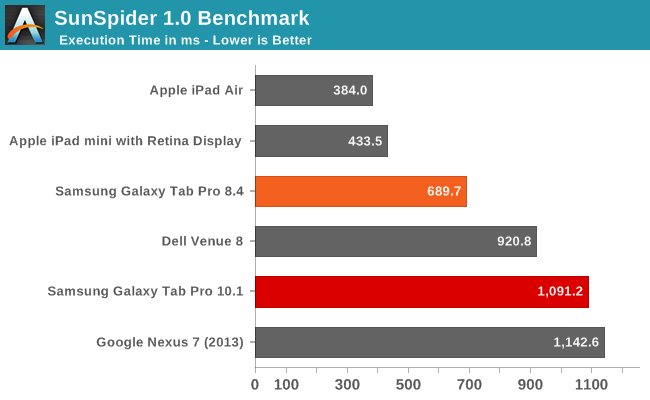
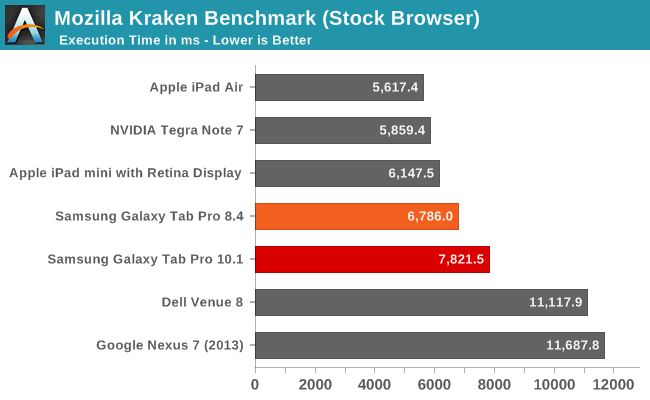
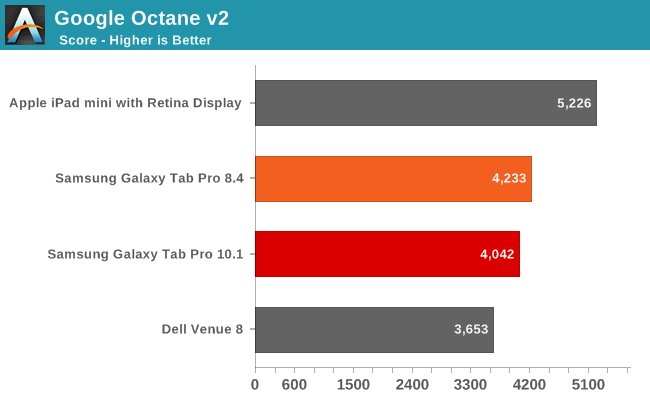

In terms of CPU speed, the Apple A7 chips still take the lead in all of our tests, though not always by a large margin. We’re also using different browsers (Chrome vs. Safari), and JavaScript benchmarks aren’t always the greatest way of comparing CPU performance. I ran additional benchmarks on the two Samsung tablets just to see if I could get some additional information; you can find a table of results for AndeBench, Basemark OS II, and Geekbench 3.
| CPU/System Benchmarks of Samsung Galaxy Tab Pro | |||
| Benchmark | Subtest | Tab Pro 10.1 | Tab Pro 8.4 |
| Andebench | Native | 13804 | 17533 |
| Java | 708 | 790 | |
| Basemark OS II | Overall | 865 | 1062 |
| System | 1542 | 1529 | |
| Memory | 419 | 503 | |
| Graphics | 1032 | 2555 | |
| Web | 838 | 724 | |
| Geekbench 3 | Single | 942 | 910 |
| Multi | 2692 | 2847 | |
| Integer Single | 1028 | 967 | |
| Integer Multi | 3135 | 3343 | |
| FP Single | 897 | 848 | |
| FP Multi | 3106 | 3080 | |
| Memory Single | 860 | 922 | |
| Memory Multi | 982 | 1391 | |
Interestingly, the Samsung Exynos 5 Octa 5420 just seems to come up short versus the Snapdragon 800 in most of these tests. However, there’s a bit more going on than you might expect. We checked for cheating in the benchmarks, and found no evidence that either of these tablets was doing anything unusual in terms of boosting clock speeds. What we did find is that the Pro 10.1 is frequently not running at maximum frequency – or anywhere near it – in quite a few of our CPU tests.
Specifically, Sunspider, Kraken, and Andebench had the cores hitting a maximum 1.1-1.3GHz. The Pro 8.4 meanwhile would typically hit the maximum 2.3GHz clock speed. The result, as you might imagine, is that the 8.4 ends up being faster, sometimes by a sizeable margin. Basemark OS II, Geekbench 3, and AnTuTu on the other hand didn’t have any such odd behavior, with the Pro 10.1 often hitting 1.8-1.9GHz (on one or more cores) during the testing, and when that happens it often ends up slightly faster than the Pro 8.4.
Which benchmark results are more "valid"? Well, that's a different subject, but as we're comparing Samsung tablets running more or less the same build of Android, we can reasonably compare the two and say that the 8.4 has better overall performance. Updated drivers or tweaking of the power governor on the 10.1 might change things down the road, but we can only test what exists right now.
Overall, both systems are sufficiently fast for a modern premium tablet, so I wouldn’t worry too much about whether or not you’re getting maximum clock speeds in a few benchmarks – in normal use you likely won’t notice one way or the other. But we’re only talking about the CPU performance when we say you won’t see the difference; let’s move over to the graphics benchmarks to see how the Galaxy Pro tablets fare.
Graphics Performance
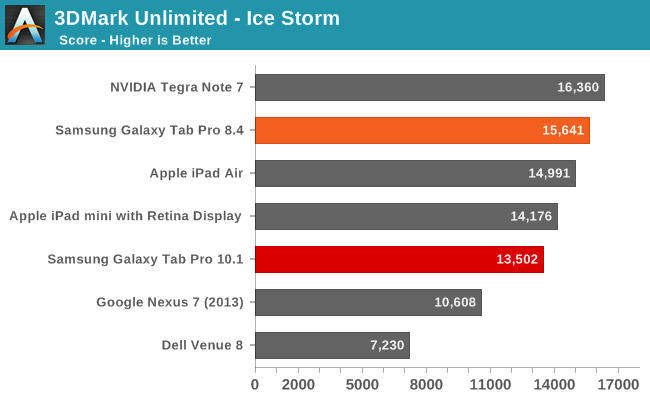
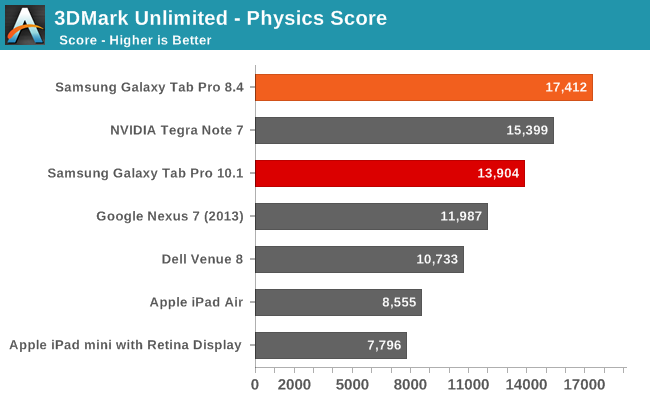
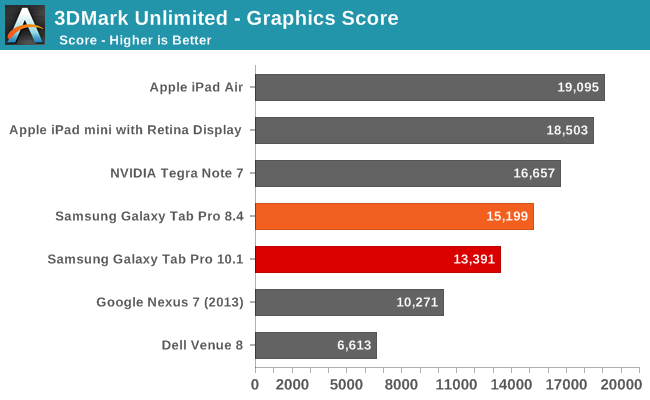
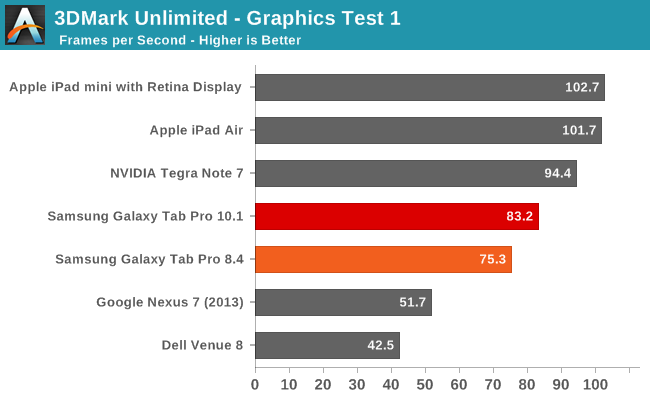
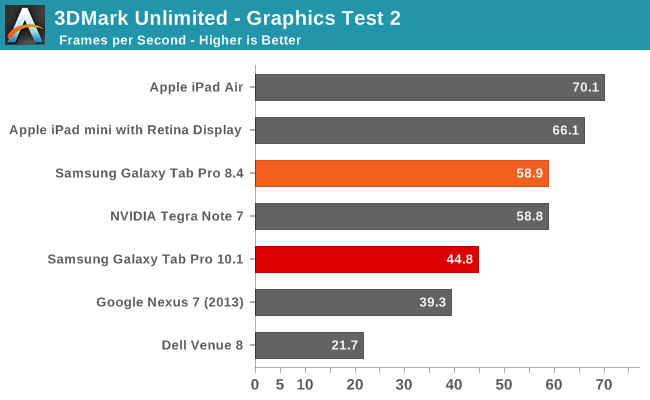
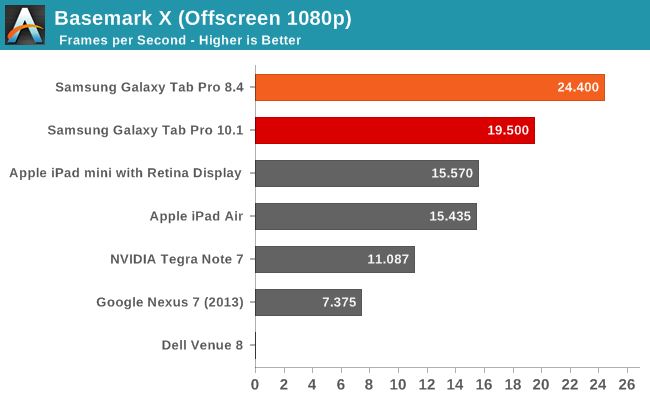
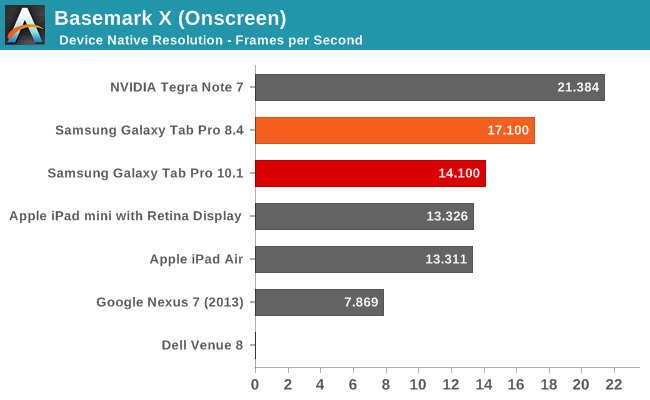
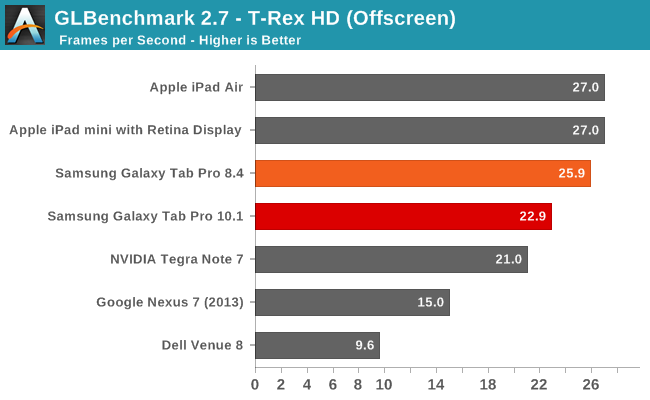
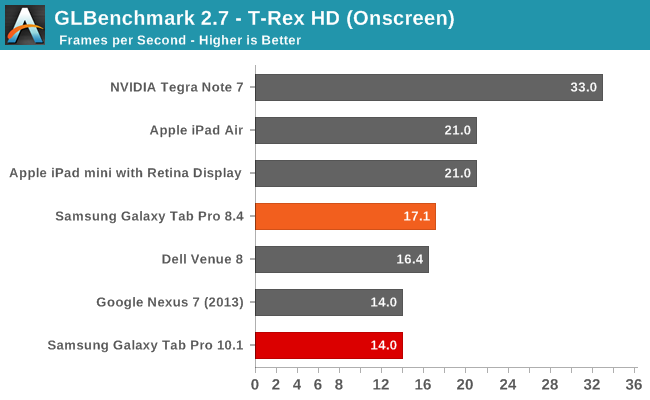
Outside of the 3DMark Unlimited Graphics Test 1 result, the Pro 8.4 sweeps the tables against its big brother. Playing games like Angry Birds Go! or any other reasonably demanding 3D titles in my experience confirms the above results – Adreno 330 beats the Mali-T628; end of discussion. I also had a few quirks crop up with the Pro 10.1 graphics, like Plants vs. Zombies 2 at one point stopped rendering all the fonts properly; a reboot fixed the problem, but I may have seen one or two other rendering glitches during testing. I have some additional results for GPU testing as well via GFXBench 3.0 if you’re interested:
| Graphics Benchmarks of Samsung Galaxy Tab Pro | |||
| Benchmark | Subtest | Tab Pro 10.1 | Tab Pro 8.4 |
| GFXBench 3.0 Onscreen | Manhattan (FPS) | 2.9 | 5.8 |
| T-Rex (FPS) | 14 | 17.1 | |
| ALU (FPS) | 13 | 59.8 | |
| Alpha Blending (MB/s) | 3295 | 6847 | |
| Fill (MTex/s) | 1956 | 3926 | |
| GFXBench 3.0 Offscreen | Manhattan (FPS) | 5.5 | 10.8 |
| T-Rex (FPS) | 22.9 | 25.9 | |
| ALU (FPS) | 25.6 | 138 | |
| Alpha Blending (MB/s) | 3093 | 7263 | |
| Fill (MTex/s) | 1956 | 3780 | |
The new Manhattan benchmark was one of the other tests where the Pro 10.1 didn’t seem to render things properly, and even then the Pro 8.4 ends up with nearly twice the frame rates. The ALU, Alpha Blending, and Fill rate scores might explain some of what’s going on, where in some cases the Pro 8.4 is more than four times as fast. Regardless, if you want maximum frame rates, I’d suggest getting the Pro 8.4 over the 10.1.










125 Comments
View All Comments
Death666Angel - Wednesday, March 26, 2014 - link
True, Apple devices sell for more on the 2nd market. But considering that they also cost usually 600€ or more (I remember a time when non-contract iPhones were 800€), you also pay a lot more up front. I've paid 500€ for a Galaxy S2 because I imported it from the UK and got it as one of the first in Europe. I ended up selling it for 180€ 18 months later. An iPhone would have cost me about the same (320€, taking the upfront price and subtracting the resell price). But that is a rubbish deal either way. I'm not going to spend more than 350€ for a phone these days. Resell value or not. And I also know a lot of people who have rubbish iPhones (mostly 4 and 4s) that keep rebooting randomly, have bad battery life, weird issues. They can't resell those for more than 50€. And they are all out of warranty of course. So really, you are making an anecdotal argument, that will only be true for some people and for a lot of others it won't.ESC2000 - Friday, March 28, 2014 - link
See my post below - just checked what the iPad 4 and the nexus 7 2013 would command on amazon and in both cases it was 65% of the MSRP. It makes sense that apple products from three years ago command more than android products from three years ago bc all apple products were better then but they aren't anymore so expect to see the resale values gap closing. There is still some downward pressure on the resale value of Android (and Windows) products bc there are more models and more devices period.Also anyone who would pay $350 for an iPhone 4 is just stupid, I'm sorry. I get platform dedication blah blah blah but when you could have a new nexus 5 for the same price it's time to let go of brand allegiance.
ESC2000 - Friday, March 28, 2014 - link
Btw I just went and checked amazon and either your price aren't representative or you're lying. Both devices on there are going for about $200 used (assuming the iPhone didn't have like 64 GB storage while the note had 16 or something). NEW iPhone 4s were going for $350. Nice try LOL. Here it is for everyone to see:http://www.amazon.com/Samsung-Galaxy-Note-SGH-i717...
http://www.amazon.com/Apple-iPhone-4S-16GB-White/d...
StrangerGuy - Saturday, March 22, 2014 - link
The only performance benchmark that only matters these days is the eMMC speed. Who cares about how much bazillion FPS in 3D when everything else stutters everywhere.UltraWide - Sunday, March 23, 2014 - link
So very true!jasonelmore - Monday, March 24, 2014 - link
and RAM. RAM dictates how long the device will be servicable and recieve updates. Apple's ipad line is gimped by their 1GB of RAM. They did it on purpose. 2 years from now, the device will start going slow because apple's 2014-2015 devices will all have 2GB or even 4GB of ram, which in turn, makes app developers use more of it. My ipad air's keyboard is stupidly slow to react to typing thanks to its horrible memory bandwidth on a almost 3 MP screen.akdj - Monday, March 24, 2014 - link
May wanna get it checked out. 7.1 made MASSIVE leaps forward with a 'brand new' rewrite of OS7. I've got three Airs and four iPad 4s. All are incredibly responsive, no crashing and fast as hell (we run an audio/video production company.ESC2000 - Tuesday, March 25, 2014 - link
Well then you are in the minority bc the three ipad air /retina ipad minis in my house regularly crash, a couple times a week, usually in safari. They also randomly reboot. I've teased my family about it bc my $230 nexus 7 (2013) is more reliable than their $400+ ipads. I've also sat them down next to each other and the screen and responsiveness of the nexus 7 matches the ipads despite being so much cheaper.I think the low amount of RAM in the ipads is contributing to the crashing. When I had an iPhone I was limited to eight tabs in safari which I assumed was bc it didn't have the internal memory to handle more. I've heard that the new ios update fixes the crashing and rebooting problem (which we know is real btw bc apple copped to it and claimed to be fixing it).
And the person who was claiming that all apple products have better resale value - that was true in the apple's edge is eroding. Three years ago apple products were objectively ahead of Android products so, fast fwd a few years to last year or this year when you're reselling them, and you see that apple products command a higher amount of money. But if you're talking about products released a year ago, Apple was no longer decisively the best phone or tablet manufacturer, so the gap has started to close. I just compared the price a used nexus 7 2013 and a used ipad 4 were going for on amazon and they were both going for around 65% of their original price.
Vigneshj - Sunday, March 23, 2014 - link
Will Samsung be releasing AMOLED display on tablet..? Watching movies/netflix can be a treat in AMOLED in large displays.StrangerGuy - Sunday, March 23, 2014 - link
Screw AMOLED? I'm far more concerned about the Pentile 2 subpixels per pixel shenanigans invading the LCD space here, from Samsung no less. I'm surprised the reviewer didn't even touch upon this.